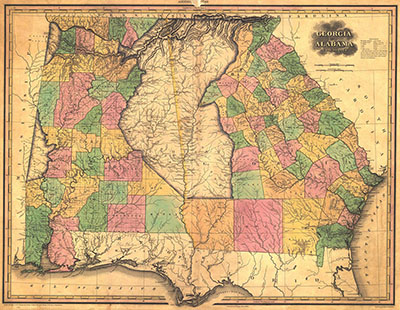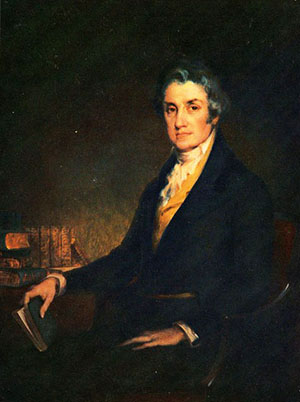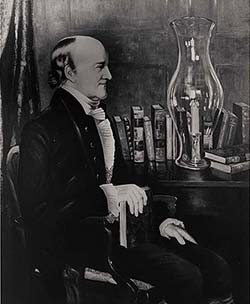[vc_row][vc_column][vc_video link=”https://www.youtube.com/watch?v=C7y955alvWY”][vc_column_text]It was 231 years ago this week — Jan. 27, 1785, to be precise — that the members of the Georgia General Assembly established the University of Georgia as the first public land-grant university. That’s why we celebrate Founders Week (check out all the events).
Yes, you probably know the year, and know that Abraham Baldwin (that statue watching over North Campus) was the first president, and that we were the first chartered university. But did you know that Baldwin was only 14 when he entered Yale?
Some more Founders Day facts:
 — James Edward Oglethorpe established the colony of Georgia, having landed at the Savannah River in 1733. Several yew trees from Oglethorpe’s home in England were planted along the Academic Building on Broad Street.
— James Edward Oglethorpe established the colony of Georgia, having landed at the Savannah River in 1733. Several yew trees from Oglethorpe’s home in England were planted along the Academic Building on Broad Street.
— In 1783, Gov. Lyman Hall delivered this message to the state legislature, planting the seed for a land-grant university:
“Every encouragement ought to be given to introduce religion and learned clergy to perform divine worship in honor of God and to cultivate principles of religion and virtue among our citizens. For this purpose it will be your wisdom to lay an early foundation for endowing seminaries of learning. Nor can you, I conceive, lay better than by a grant of land that may, as in other governments, hereafter by lease or otherwise, raise a sufficient revenue to support such valuable institutions.”
 — Abraham Baldwin (left) entered Yale College at the age of 14 and received a Bachelor of Arts in 1772. He went to divinity school and was licensed to preach in 1775. After a stint as a Yale University tutor and army chaplain, he became a Professor of Divinity at Yale at the age of 27. A bit of an overachiever?
— Abraham Baldwin (left) entered Yale College at the age of 14 and received a Bachelor of Arts in 1772. He went to divinity school and was licensed to preach in 1775. After a stint as a Yale University tutor and army chaplain, he became a Professor of Divinity at Yale at the age of 27. A bit of an overachiever?
— We don’t know for sure how Baldwin ended up in Georgia. It is thought that he arrived in Connecticut, moved to Charleston, and then traveled into Augusta, the capital at the time.
— In 1784, the legislature granted him permission to practice law.
— He quickly added politician to his resume. On Jan. 12, 1785, he became a state legislator. He didn’t waste time. On Jan. 27, 1785, he got UGA’s first charter introduced and approved. Baldwin was named president.
— Written in ink on two faded and yellowed sheets of vellum, 19 1/2 by 32 1/2 inches, the charter is kept in the Rare Books Room of the University of Georgia Library and is only displayed on Founders Day each year.
— Chancellor (from 1906 to 1925) David C. Barrow said the first line from the charter was among the great sentences in the English language:
“As it is the distinguishing happiness of free governments that civil order should be the result of choice and not necessity, and that the common wishes of the people become the law of the land, their public prosperity and even existence, very much depends upon suitably forming the minds of their citizens.”
— The charter established the Board of Visitors to “see that the intent of this institution is carried into effect” along with the Board of Trustees. The two bodies together were the “Senatus Academicus of the University of Georgia.”
— Baldwin was soon elected to the Continental Congress and through the next decade or so, spent the bulk of his time on national affairs.
— Baldwin never married.
— Baldwin died in 1807 at age 53. He was serving as a U.S. senator from Georgia at the time.
— In the 16 years between the signing of the charter and the establishment of the university in Athens, action toward establishing the university slowed, often because it was hard to get a quorum of the board. As historian Thomas Reed said, “Then the Board of Trustees went to sleep for the next eight years.”
— During this time, North Carolina chartered a university in 1789 and opened its doors to classes in 1795. Hence, the centuries-old debate about who was the first land-grant university.
 — The initial salary for second President Josiah Meigs (left), who took the helm in 1801 and was the first president to preside over a class, was $1,500 per year.
— The initial salary for second President Josiah Meigs (left), who took the helm in 1801 and was the first president to preside over a class, was $1,500 per year.
— The board of trustees still had not decided on a location after hiring Meigs in 1801. They narrowed it down to five counties: Franklin, Hancock, Greene, Oglethorpe and Jackson (Clarke County split from Jackson County in 1801). They inspected the land, and according to historian Reed:
“They came upon a high hill around whose base flowed the Oconee River, then a clear and beautiful stream … through a grove of cedars its waters danced over shoals for quite a distance, hence the name of Cedar Shoals. … The hillsides were covered with lordly trees, pine, oak and hickory. Several bold, clear springs were there whose sparkling waters descended swiftly to the river. One of those springs was near the crest of the hill in easy reach of the place where college buildings would be erected, thus guaranteeing an abundance of pure drinking water for the professors and students of the coming years.”
— The land was owned by Daniel Easley, who had built a mill on that location (near the present-day School of Social Work building). John Milledge, a member of the trustees’ location committee and soon thereafter Georgia governor, managed to buy 633 acres from Easley, and then donated it to the university.
— Georgia artist George Cooke’s “View of Athens from Carr’s Hill” (above, 1845) is on display at the Hargrett Rare Book and Manuscript Library on the UGA campus.
— Even before the first building was erected, Meigs recruited the first class of students, some who might have reported in late 1801.
— The university constructed its first building, which was originally called Franklin College and is now known as Old College.
— The first class graduated on May 31, 1804.
Thus began the birthplace of public higher education.
(Source: UGA)
[/vc_column_text][/vc_column][/vc_row]



